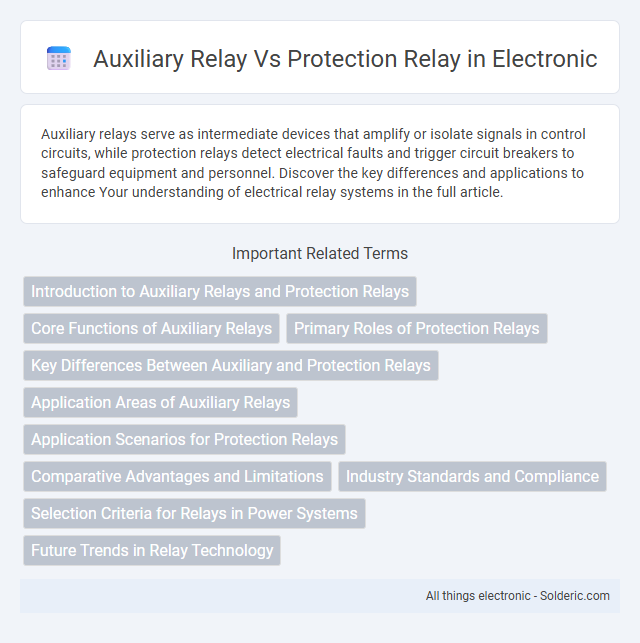Auxiliary relays serve as intermediate devices that amplify or isolate signals in control circuits, while protection relays detect electrical faults and trigger circuit breakers to safeguard equipment and personnel. Discover the key differences and applications to enhance Your understanding of electrical relay systems in the full article.
Comparison Table
| Feature | Auxiliary Relay | Protection Relay |
|---|---|---|
| Purpose | Signal amplification and control switching | Electrical fault detection and system protection |
| Function | Acts as interface between control devices and main circuits | Triggers circuit breakers to isolate faults |
| Operation Type | Electromechanical or solid-state | Electromechanical, solid-state, or digital microprocessor-based |
| Sensitivity | Low sensitivity; designed for switching operations | High sensitivity; designed to detect abnormal conditions |
| Typical Application | Control panels, automation, interlocking circuits | Power systems, transformers, generators protection |
| Response Time | Moderate | Fast to instantaneous for fault isolation |
| Complexity | Simple design | Complex design with adjustable settings |
| Example | Control relay in motor starters | Overcurrent relay, differential relay |
Introduction to Auxiliary Relays and Protection Relays
Auxiliary relays serve as supporting devices in electrical systems, enabling control and signaling functions by amplifying or isolating circuits. Protection relays monitor electrical parameters such as current, voltage, and frequency to detect faults and trigger circuit breakers to prevent damage. Understanding the distinct roles of auxiliary relays and protection relays ensures your electrical system operates safely and efficiently.
Core Functions of Auxiliary Relays
Auxiliary relays primarily serve to support the operation of protection relays by providing signal amplification, logic control, and electrical isolation within power systems. They facilitate functions like switching, interlocking, and indication, ensuring coordinated and reliable relay operation. Unlike protection relays, auxiliary relays do not directly detect faults but enhance the protection system's overall functionality and safety.
Primary Roles of Protection Relays
Protection relays primarily serve to detect electrical faults and initiate circuit isolation to prevent damage to equipment and ensure system stability. They monitor parameters such as current, voltage, frequency, and phase angle to identify abnormal conditions like overloads, short circuits, or ground faults. Auxiliary relays, in contrast, function as support devices, facilitating control logic, signal amplification, and interlocking mechanisms within relay protection schemes.
Key Differences Between Auxiliary and Protection Relays
Auxiliary relays primarily function as interface devices, amplifying or isolating control signals in electrical circuits, whereas protection relays detect faults and initiate circuit breaker operations to safeguard electrical equipment. Protection relays rely on parameters such as current, voltage, and frequency deviations to trigger protective actions, while auxiliary relays respond to control circuit inputs without fault detection capability. The distinct role of protection relays in system safety contrasts with the auxiliary relay's role in control signal management and relay logic operations.
Application Areas of Auxiliary Relays
Auxiliary relays are widely used in control circuits for switching, indication, and interlocking purposes within industrial automation, motor control centers, and signal interface systems. Protection relays primarily function in power system protection to detect faults and initiate circuit breaker operations, safeguarding transformers, generators, and transmission lines. Auxiliary relays ensure operational reliability in control panels, while protection relays secure electrical networks from overloads, short circuits, and ground faults.
Application Scenarios for Protection Relays
Protection relays are primarily used in power systems to detect faults and initiate circuit breaker operations, ensuring system stability and safety in industrial plants, substations, and electrical grids. These relays monitor parameters such as current, voltage, frequency, and impedance to provide real-time protection against overloads, short circuits, and equipment failures. Their application scenarios include fault detection in transformers, generators, transmission lines, and motors, where rapid and precise response is critical to minimize damage and maintain reliable power supply.
Comparative Advantages and Limitations
Auxiliary relays offer advantages in amplifying control signals and providing additional contacts for complex relay logic, making them ideal for control circuits with low current requirements. Protection relays excel in detecting electrical faults such as overcurrent, under-voltage, and short circuits, ensuring system safety and preventing equipment damage through rapid response times. Your choice depends on whether you need precise fault detection for system protection or versatile signal amplification and control in automation tasks.
Industry Standards and Compliance
Auxiliary relays and protection relays must adhere to stringent industry standards such as IEC 61850 and IEEE C37.90 to ensure reliability and safety in electrical systems. Protection relays are designed to meet compliance requirements for fault detection and system isolation, while auxiliary relays focus on control and signaling functions within these standards. Ensuring your relay selection complies with relevant regulations helps maintain system integrity and operational efficiency.
Selection Criteria for Relays in Power Systems
Selection criteria for auxiliary relays in power systems emphasize reliability, contact configuration, and coil voltage compatibility to ensure proper signaling and control functions. Protection relays require precise sensitivity, fast operation time, and coordination with system protection schemes to detect faults accurately and isolate faulty sections. Your choice should balance operational requirements, system complexity, and fault-clearing speed to maintain network stability and safety.
Future Trends in Relay Technology
Future trends in relay technology emphasize the integration of advanced digital and IoT capabilities, enhancing both auxiliary and protection relays' functionality through real-time monitoring and predictive maintenance. Protection relays are evolving with enhanced fault detection algorithms and smart grid compatibility, while auxiliary relays are increasingly designed for higher reliability and compactness in control circuits. The convergence of AI and machine learning in relay systems promises improved decision-making accuracy and reduced downtime in electrical installations.
auxiliary relay vs protection relay Infographic

 solderic.com
solderic.com